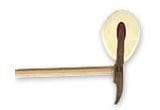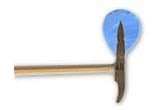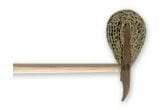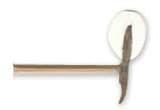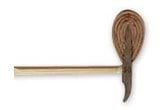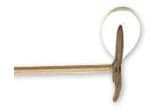[Experiment1] Changing the Material of the Hammers
How does the sound change when other materials are substituted for the felt part of the hammer? We experimented with various materials to make the hammer.
Experimenting with Different Hammer Materials
- Prepare five sets of the wood parts of the hammer.
- Instead of felt, substitute other materials formed in the shape of the hammer.
- One by one, mount each hammer in the piano action.
- Depress the key on the keyboard and listen to the sound.
Felt (normal)
Urethane foam
Corrugated cardboard
Rubber eraser
Leather
Paper clay
*The sound recorded in the experiments differs from the actual musical pitch.
We prepared hammers from a total of five different materials that were heavier, lighter, harder, and softer than felt. If the hammer was even 1 mm wider than normal, it would touch adjacent hammers and become difficult to move. If the hammer protruded vertically to any degree, the string could not be struck forcefully enough to obtain sufficient sound volume, result in a soft, weak sound. Accurately forming the shape of the hammer was the most difficult part of the experiment.
Blue urethane foam is a lighter material than felt. It produced a soft, muffled sound. When the corrugated cardboard surface hit the strings, it made a bright, crackly sound. Next was the rubber eraser. Because of its weight, we thought that it would hit the string forcefully and make a loud sound, but the sound was unexpectedly soft. The leather was split thin and rolled up in layers before being formed into the hammer shape. It produced a fairly good sound. Leather is moderately elastic, and may come close to the properties of felt. The last was Paper clay. It was the hardest and heaviest material used, and made a sharp, high-pitched sound, similar to that of a cembalo or a Taisho koto (Japanese transverse harp). The drawback is that the hammer was too heavy, and it was difficult to play repetitions because some parts of the action can't return to their at-rest position.
Of these materials, leather produced the sound closest to felt. However, even when you vary the strength used to depress the key, there was almost no change in the tone of the note. With felt, the harder one depresses the key, the louder the sound, and the impression of the note produced changes from a soft feeling to a strong, powerful feeling.
Musical Instrument Guide : Piano Contents
Origins
Structure
How to Play
How the Instrument is Made
Choosing an Instrument
Care and Maintenance
Trivia
- The White Keys and Black Keys Were Reversed on Pianos in Mozart's Day
- Did Mozart's Piano Have a Pedal-Board?
- Piano with Automatic Accompaniment System in Beethoven's Day
- The Pianos Beloved by the Great Master, Sviatoslav Richter
- The Optimal Material for Piano Frames Is Also Ideal for Motorcycle Engines
- The Piano Soundboard Is a Board that Also Stops Vibrations
- Why Can't There Be More Than 88 Keys on a Piano?
- Why a Grand Piano Keyboard Feels Heavier Than an Upright Keyboard?

